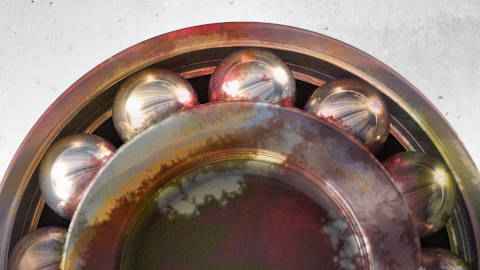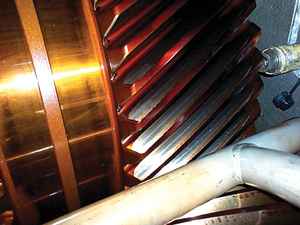ASTM Standards Are Evolving to Effectively Monitor Varnish
 Varnish is defined as the matter that precipitates from a lubricant and collects on surfaces. If this material accumulates on components, such as servo valves, or within oil systems, it can lead to maintenance and reliability headaches.
Varnish is defined as the matter that precipitates from a lubricant and collects on surfaces. If this material accumulates on components, such as servo valves, or within oil systems, it can lead to maintenance and reliability headaches.
With the introduction of Group II and Group III oils in the early 2000s, varnish deposits became increasingly severe. It was discovered that these oil groups couldn’t retain varnish solutions in the capacities of older-generation-formulated products.
While progress has been made in learning how to test oil to show its varnish potential, challenges and information gaps still exist. ASTM D02 Subcommittees C and CS96 members are furthering the knowledge base about this important topic.
The Relationship Between MPC, RPVOT, and RULER
One promising area of research centres around the relationship between the ASTM tests used to characterize parameters of an oil’s varnish formation tendency. These tests include:
- ASTM D7843 (MPC)
- ASTM D2272 (RPVOT)
- ASTM D6971 (RULER)
Each of these provides data focused on monitoring different aspects of an oil’s degradation by-products. It was discovered that trending each test independently does not provide a highly reliable forecast of expected overall oil performance as it relates to varnish formation and collection.
 Utilizing ASTM D7873 (dry TOST) can determine the relationships between these tests. The dry TOST test is a method that accelerates oil ageing and is believed to produce aged oils similar in chemistry to how the oils would age in service.
Utilizing ASTM D7873 (dry TOST) can determine the relationships between these tests. The dry TOST test is a method that accelerates oil ageing and is believed to produce aged oils similar in chemistry to how the oils would age in service.
During one study, samples were removed after three, six, nine, and 12 weeks of exposure to the test conditions. RPVOT, MPC, and RULER tests were then run on each test sample. The study found that some oils with strong RPVOT performance produced more varnish deposits than oils with low RPVOT measurements. Conversely, some oils with strong antioxidant protection had a greater tendency to leave varnish deposits than oils with less oxidation protection. Both findings are non-intuitive.
The shape of the RPVOT test degradation curve over the period represented by the four aged samples also differed between different turbine oil brands. Some oils had an initial rapid test drop before assuming a gentle degradation rate. Other samples assumed a gentle degradation rate during the entire test period. This information may present one explanation of why some oils believed to be high performing formed more varnish than expected.
The relationship between these test methods is an active ASTM work item that will result in a revision to ASTM D7873 with new industry guidance that will provide users with a tool for selecting turbine oils.
Phosphate Esters
Fire-resistant triaryl phosphate ester-based fluids are used extensively in control oil systems, but are currently outside the scope of the D7843 (MPC) test. However, because they are known to degrade, oxidize, and form varnish deposits, they will benefit from MPC testing.
Further research into these mechanisms has been performed, and ASTM agreed the MPC test method would be amended to include fire-resistant oils in the next revision of the standard test method. Proper monitoring of the phosphate ester oil varnish deposits being produced will require the collection of additional information beyond the current requirements of the MPC test.
In addition to an overall rating, the membrane patch colour was found to have distinctive components related specifically to both varnish and thermolysis. When thermolysis occurs, certain matter originates from the micro-dieseling events that take place within the oil system. To trend the additional matter formed from thermolysis, the MPC test will soon report:
- The overall colour measurement.
- The weight of the as-found patch deposit.
- The colours of “A” and “B” component deposits.
The “A” and “B” colour components measured by the proposed test revision are used to determine if the overall MPC colour is primarily carbon-based (micro-dieseling) or varnish-based (oxidation). A deeper understanding of the source of the material captured on the MPC patch will aid the user in:
- Performing root-cause investigations following a servo valve failure.
- Determining when remedial corrective action is required.
Trending the Effects of Micro-Dieseling
Turbine electro hydraulic control (EHC) oil systems won't operate optimally without exceptionally clean oil (as defined by the ISO cleanliness criteria). Other testing has demonstrated that, in addition to material originating from oxidation reactions, this oil type tends to produce a significant volume of particles that are smaller than the 4-micron limitation of the ISO cleanliness test but larger than the 0.45-micron patch that is used to collect deposits in the MPC test.
These particles, when abundantly present in the operating oil system, can lead to particulate etching and failure of the servo values. The extent of the presence of these extremely small particles should also be used to develop a new condemning criterion to replace the oil that other available testing would likely miss.
Summary
There is still much to learn about the formation of varnish and its impact on oil and machine health. Updates to formulations, particularly in Group II, Group III, and phosphate esters, have resulted in unexpected varnish accumulations. Oil varnish trending needs to be a routine part of condition monitoring programs. In some cases, particularly with phosphate esters, recent studies have found that varnish plus additional oil artefacts generated during operation should be trended.
With this new information and data, advances are being incorporated by ASTM to improve existing standards methods to keep up with the different types of varnish created because of the evolving oil formulations and the increasing understanding of new varnish mechanisms. Additional information on varnish studies and how they are being incorporated into ASTM standards may be found in a recently published ASTM STP Document: STP 1634 Standard Guides and Practices that Support the Lubricant Condition Monitoring Industry.
ASTM’s D02 committee provides the condition monitoring industry with a voice and place to improve the profession and technology. The D02 C and CS96 subcommittees manage and author new and in-service lubricant condition monitoring standards. The subcommittee’s primary responsibility is to develop standards that promote knowledge and innovation, while ensuring that appropriate testing is being performed and that resulting data is correctly implemented.
Questions about ASTM D02 Subcommittee C on Turbine Oil Monitoring may be directed to Subcommittee C Chair Mindy Villalba at mindy.villalba@sgs.com.
Questions about ASTM CS96 Subcommittee on in-service lubricant condition monitoring may be directed to CS96 Subcommittee Chair Lisa Williams at lisa.williams@ametek.com.
ASTM International, a global volunteer-driven standards organization, serves a significant role in today’s condition monitoring industry. ASTM is known for laboratory test methods that provide instruction used to obtain consistent and reliable data. In addition to test methods, ASTM products include Guides and Practices that provide useful “how to” recommendations, some of which include test acceptance and action-level criteria that can be used to enhance the effectiveness of both common maintenance practices and in the use of condition monitoring test data. ASTM is a source of research and innovation that has and will continue to shape the future of the condition monitoring industry. One of the more significant topics of condition monitoring discussions in recent years has been related to varnish.
Acknowledgments:
Special thanks to Greg Livingstone, Fluitec International, and Dr. M. Hobbs, EPT Clean Oil.
